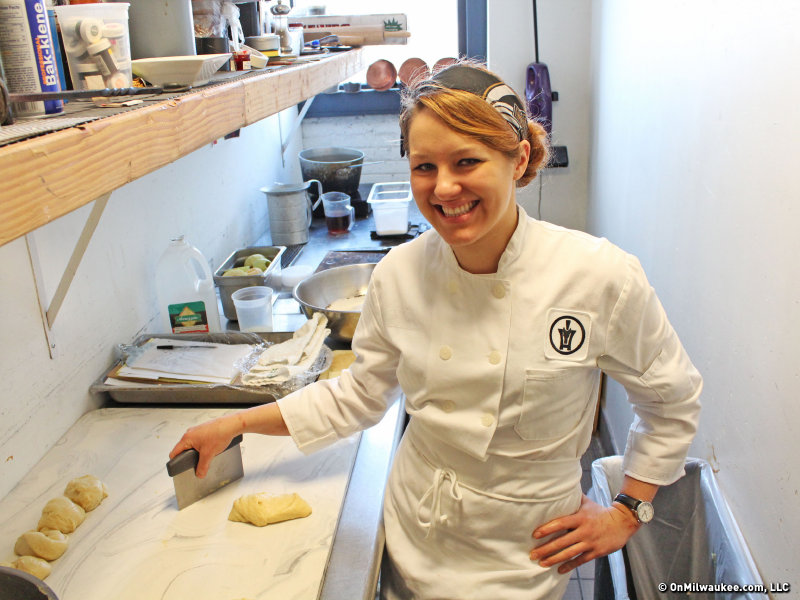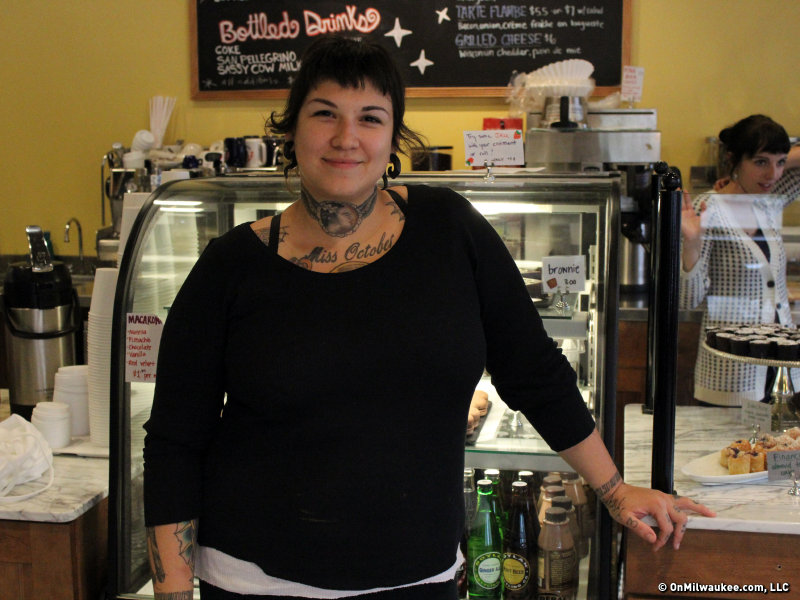Kelsey Williamson, pastry chef for the Iron Horse Hotel, is a relative newcomer to the restaurant scene, as well as to the city of Milwaukee.
Originally from Des Moines, Iowa, Williamson says she always entertained the thought of going to culinary school. But, it wasn’t her first move. After graduating from high school, she was admitted to the University of Minnesota for a program in International Studies.
She says she stuck with it until her very last semester, when ultimately, her dream won out. Instead of finishing her thesis, she left the university to study pastry at the Art Institute International in Minneapolis. The rest, they say is history.
Williamson acquired her first pastry position when one of the instructors from the institute recommended her for what she thought was a temporary unpaid position at Minnesota Valley Country Club. The position turned out to be a full-time job where she gained a wealth of experience working in both pastry and as a sous chef for banquet management.
She moved to Milwaukee this summer to take on a new position as pastry chef at the Iron Horse, where she has assisted in revamping the restaurant’s dessert and bread offerings.
I sat down with Williamson recently to chat about her background in food, her impressions of Milwaukee, and her opinions about what’s hot (and not) in pastry.
OMC: Talk to me about food. What role did it play in your life as you were growing up?
KW: My mother cooked every night and there was almost always some sort of dessert in the house. My grandmother worked in a Czech bakery, and just about everyone in my family knows how to make a Danish, eclairs, cheesecake. I grew up thinking that everyone could.
OMC: So, food played an important role in your family?
KW: Yes, absolutely. Family, for me, was very much centered around family dinner. We always sat down and ate together.
My siblings and I are also competitive, so if one was good at something, the others always had to try to get even better. I learned to cook in that environment.
OMC: Sounds like fun.
KW: We also played practical jokes on one another. I once ate a mayonnaise éclair. It was not good.
OMC: So, why did you choose to study pastry?
KW: I love savory cooking. But, in my heart I’m more of a baker. I love making breads. There’s something so magical about taking a living piece of bread to nourish your family. There’s a saying "All troubles are less with bread," and I totally believe it. I’m also very precise, so that lends itself well to the process of baking.
OMC: Do you think having a pastry chef separate from the chef is important?
KW: I would say that it depends on who you have in the kitchen. If you have staff with the time and inclination to take care of it, then it can work out well. For instance, in small restaurants, people often have to take on a lot more roles to really make things work. But, in other situations, it’s not ideal. When I stepped in here, most of the desserts and baked goods were coming out of the freezer. And that’s what happens when you don’t have someone dedicated to the task.
OMC: What is your goal when you’re creating a menu for the customers at the Iron Horse?
KW: This hotel is meant to be Milwaukee, to epitomize it. So, my goal is to give people a taste of Milwaukee.
OMC: What is a "taste of Milwaukee?"
KW: I knew very little about Milwaukee before I came here. It’s surprisingly German. I love making apple struedel, so that’s not a bad thing for me. I’ve also learned that in Milwaukee, you shouldn’t be afraid to booze up your food. Also not a bad thing.
Milwaukee tends to love the classic desserts. They want to read the menu and know exactly what they’re going to get. It’s our job to surprise them.
Here people tend to be doing takes on classic desserts. One example is the dreamsicle dessert at SURG. One of my favorite desserts right now is a candy bar cake.
OMC: Mmm. What’s candy bar cake?
KW: It’s a whiskey chocolate cake with layers of Frangelico mascarpone cream and chocolate ganache, topped with croquant and whiskey caramel. It’s crunchy, chocolately. Perfect.
OMC: Can you make whatever you want for the dessert menu, or do you have to run it by the chef?
KW: The last two menus I wrote myself. They do go through an approval process, but I have quite a bit of freedom to do what I’d like to do.
OMC: How are you stretching your skill set in your role at the hotel?
KW: Well, I’m constantly working with new ingredients. I made a truffle brioche with house made bacon and eggs for the dinner menu – how much fun does that sound like? Truffles were something new for me to work with. So, I’m getting new experiences like that every day.
OMC: They say pastry is a lost art – but that it’s coming back around. What classic techniques are you working to master?
KW: Mostly working with Danishes and croissants – laminated doughs that are more delicate. In our kitchen it’s a challenge since it’s all about temperature and space. It’s so hot that you have to work incredibly fast. And my small space fills up really quickly.
OMC: Which ones drive you nuts?
KW: You know, I was reading another pastry chef’s interview and she was talking about how she loves to make custards because it feels so great when they really turn out perfectly. That’s totally true. I hate making custards. It’s really, really great when you get it right.
OMC: You hate custard?
KW: Yeah, I’m just a small person and my arm gets really tired.
OMC: Where would you place yourself on the continuum of classic to innovative?
KW: I’m much closer to the classical side. I’m not a big fan of some of the molecular gastronomy. I find it interesting, but I don’t find a lot of use in doing it myself. It’s all for show, and I’m more focused on the quality of the product, the flavors. Not putting on a show.
OMC: Who are your biggest influences?
KW: We’ve never met, but John Krause in Minneapolis is phenomenal. He is at Patisserie 46. Everything there is just done right. They put in all the time, all the labor, and they use the right ingredients. It’s a commitment to a higher cost, but everything is beautiful. And it tastes amazing. I’m hoping to work with him someday. He doesn’t know it, but it’s on my wish list.
OMC: What’s one of your favorite things you’re working on right now?
KW: This is a slow time for us, so I have time to play. I love making doughnuts, so I’ve been making a different flavor every week for brunch. One of the favorites I’ve done so far was … well, I took fat rendered from pork belly and incorporated it into the dough and paired that with maple cream and a lemony glaze.
OMC: What ingredient is currently over-used by people on the pastry side?
KW: I feel like there is a big reliance on chocolate and caramel to make a dessert good. I definitely use the flavors, but I feel like so often it’s just extra and just there because you had it and people would eat it. I think it’s way more difficult to make a great dessert without them.
OMC: What ingredient should be used more often?
KW: I know flavors I love – love bergamot, steeped in cream or as a part of a ganache. It’s big, lovely orangey and floral. I did pistachio macarons with a bergamot ganache filling not long ago. So good.
OMC: Are there dishes you’d love to make but suspect people wouldn’t order?
KW: Well… I actually have an example of the reverse of it. I made something that I really loved, but that I figured no one would really get excited about. It was a cardamom brioche pain perdu with spiced apples, praline and browned butter ice cream. But, people really loved it.
But, hmm… things I love that don’t really ever go out the door … Well, for New Year’s Eve, I did an almond pound cake with persimmon mousse, crème fraiche, and candied citrus peel. It didn’t really go over all that well, but I loved that dessert.
OMC: OK, let’s talk about home cooks. What one hint do you have that might change someone’s life in the kitchen?
KW: Mixing batters. I’ve become very particular about it. People think you just throw ingredients together, but there’s a process to it. For instance, you really do have to add your eggs one at a time when you’re making a cake; it will rise more. And sometimes you have to sacrifice those last few stirs to prevent your cake from getting too tough.
Lori is an avid cook whose accrual of condiments and spices is rivaled only by her cookbook collection. Her passion for the culinary industry was birthed while balancing A&W root beer mugs as a teenage carhop, fed by insatiable curiosity and fueled by the people whose stories entwine with each and every dish. She’s had the privilege of chronicling these tales via numerous media, including OnMilwaukee and in her book “Milwaukee Food.” Her work has garnered journalism awards from entities including the Milwaukee Press Club.
When she’s not eating, photographing food, writing or recording the FoodCrush podcast, you’ll find Lori seeking out adventures with her husband Paul, traveling, cooking, reading, learning, snuggling with her cats and looking for ways to make a difference.





